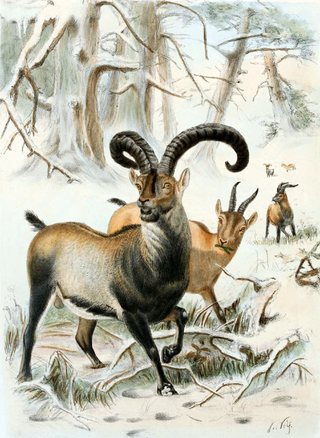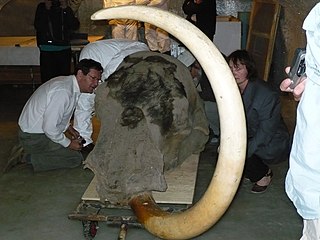Related Research Articles

A mammoth is any species of the extinct elephantid genus Mammuthus. They lived from the late Miocene epoch into the Holocene about 4,000 years ago, and various species existed in Africa, Europe, Asia, and North America. Mammoths are distinguished from living elephants by their spirally twisted tusks and in at least some later species, the development of numerous adaptions to living in cold environments, including a thick layer of fur.

Beringia is defined today as the land and maritime area bounded on the west by the Lena River in Russia; on the east by the Mackenzie River in Canada; on the north by 72° north latitude in the Chukchi Sea; and on the south by the tip of the Kamchatka Peninsula. It includes the Chukchi Sea, the Bering Sea, the Bering Strait, the Chukchi and Kamchatka Peninsulas in Russia as well as Alaska in the United States and the Yukon in Canada.

The woolly rhinoceros is an extinct species of rhinoceros that inhabited northern Eurasia during the Pleistocene epoch. The woolly rhinoceros was a member of the Pleistocene megafauna. The woolly rhinoceros was covered with long, thick hair that allowed it to survive in the extremely cold, harsh mammoth steppe. It had a massive hump reaching from its shoulder and fed mainly on herbaceous plants that grew in the steppe. Mummified carcasses preserved in permafrost and many bone remains of woolly rhinoceroses have been found. Images of woolly rhinoceroses are found among cave paintings in Europe and Asia. The range of the woolly rhinoceros contracted towards Siberia beginning around 17,000 years ago, with the youngest known records being around 14,000 years old in northeast Siberia, coinciding with the Bølling–Allerød warming, which likely disrupted its habitat, with environmental DNA records possibly extending the range of the species around 9,800 years ago. Its closest living relative is the Sumatran rhinoceros.

Dawson City, officially the City of Dawson, is a city in the Canadian territory of Yukon. It is inseparably linked to the Klondike Gold Rush (1896–1899). Its population was 1,577 as of the 2021 census, making it the second-largest city in Yukon.

Eupetaurus is a genus of rodent in the family Sciuridae. Members of this genus are known as woolly flying squirrels. They are large to very large flying squirrels found in the highest rocky cliffs near the treeline of the Himalayas and Tibetan Plateau. Due to the inaccessibility of their montane habitat, they are difficult to study.

The steppe bison or steppe wisent is an extinct species of bison. It was widely distributed across the mammoth steppe, ranging from Western Europe to eastern Beringia in North America during the Late Pleistocene. It is ancestral to all North American bison, including ultimately modern American bison. Three chronological subspecies, Bison priscus priscus, Bison priscus mediator, and Bison priscus gigas, have been suggested.

The Columbian mammoth is an extinct species of mammoth that inhabited North America from southern Canada to Costa Rica during the Pleistocene epoch. The Columbian mammoth descended from Eurasian steppe mammoths that colonised North America during the Early Pleistocene around 1.5–1.3 million years ago, and later experienced hybridisation with the woolly mammoth lineage. The Columbian mammoth was among the last mammoth species, and the pygmy mammoths evolved from them on the Channel Islands of California. The closest extant relative of the Columbian and other mammoths is the Asian elephant.

The Trʼondëk Hwëchʼin is a First Nation band government located in the Canadian territory, Yukon. Its main population centre is Dawson City, Yukon.

The mammoth steppe, also known as steppe-tundra, was once the Earth's most extensive biome. During glacial periods in the later Pleistocene it stretched east-to-west, from the Iberian Peninsula in the west of Europe, across Eurasia to North America, through Beringia and northwest Canada; from north-to-south, the steppe reached from the Arctic southward to southern Europe, Central Asia and northern China. The mammoth steppe was cold and dry, and relatively featureless, though climate, topography, and geography varied considerably throughout. Certain areas of the biome—such as coastal areas—had wetter and milder climates than others. Some areas featured rivers which, through erosion, naturally created gorges, gulleys, or small glens. The continual glacial recession and advancement over millennia contributed more to the formation of larger valleys and different geographical features. Overall, however, the steppe is known to be flat and expansive grassland. The vegetation was dominated by palatable, high-productivity grasses, herbs and willow shrubs.

The history of the Yukon covers the period from the arrival of Paleo-Indians through the Beringia land bridge approximately 20,000 years ago. In the 18th century, Russian explorers began to trade with the First Nations people along the Alaskan coast, and later established trade networks extending into Yukon. By the 19th century, traders from the Hudson's Bay Company were also active in the region. The region was administered as a part of the North-Western Territory until 1870, when the United Kingdom transferred the territory to Canada and it became the North-West Territories.

Lyuba is a female woolly mammoth calf who died c. 42,000 years ago at the age of 30 to 35 days. She was formerly the best preserved mammoth mummy in the world, surpassing Dima, a male mammoth calf mummy which had previously been the best known specimen.

The woolly mammoth is an extinct species of mammoth that lived from the Middle Pleistocene until its extinction in the Holocene epoch. It was one of the last in a line of mammoth species, beginning with the African Mammuthus subplanifrons in the early Pliocene. The woolly mammoth began to diverge from the steppe mammoth about 800,000 years ago in Siberia. Its closest extant relative is the Asian elephant. The Columbian mammoth lived alongside the woolly mammoth in North America, and DNA studies show that the two hybridised with each other.
Kwäday Dän Ts'ìnchi, or Canadian Ice Man, is a naturally mummified body found in Tatshenshini-Alsek Provincial Park in British Columbia, Canada, by a group of hunters in 1999. Kwäday Dän Ts'ìnchi means "Long Ago Person Found" in Southern Tutchone, and is pronounced in that language. Radiocarbon dating of artifacts found with the body placed the age of the body at between 300 and 550 years.

Yuka is the best-preserved woolly mammoth carcass ever found. It was discovered by local Siberian tusk hunters in August 2010. They turned it over to local scientists, who made an initial assessment of the carcass in 2012. It is displayed in Moscow.

De-extinction is the process of generating an organism that either resembles or is an extinct species. There are several ways to carry out the process of de-extinction. Cloning is the most widely proposed method, although genome editing and selective breeding have also been considered. Similar techniques have been applied to certain endangered species, in hopes to boost their genetic diversity. The only method of the three that would provide an animal with the same genetic identity is cloning. There are benefits and drawbacks to the process of de-extinction ranging from technological advancements to ethical issues.

The Yukagir Mammoth is a frozen adult male woolly mammoth specimen found in the autumn of 2002 in northern Yakutia, Arctic Siberia, Russia, and is considered to be an exceptional discovery. The nickname refers to the Siberian village near where it was found.

The Yunnan woolly flying squirrel is a species of very large flying squirrel in the genus Eupetaurus. It is found on the southeastern margin of the Himalayas, namely in northwestern Yunnan and potentially Myanmar.
This page lists significant events of 2022 in archaeology.
References
- ↑ "Gold Miners Accidentally Discover First Baby Woolly Mammoth in North America". My Modern Met. 2022-07-01. Retrieved 2022-07-04.
- ↑ "Woolly Mammoth Calf Discovered in Yukon Permafrost | Sci-News.com". Breaking Science News | Sci-News.com. 27 June 2022. Retrieved 2022-07-04.
- ↑ "Gold miner in Canada finds mummified 35,000-year-old baby woolly mammoth". the Guardian. 2022-06-26. Retrieved 2022-07-04.
- ↑ "Mummified baby woolly mammoth found nearly perfectly preserved with skin and hair". TimesNow. 27 June 2022. Retrieved 2022-07-04.